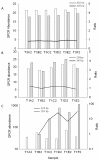Co-assortment in integron-associated gene cassette assemblages in environmental DNA samples
- PMID: 20698953
- PMCID: PMC2927473
- DOI: 10.1186/1471-2156-11-75
Co-assortment in integron-associated gene cassette assemblages in environmental DNA samples
Abstract
Background: It has been shown that integron-associated gene cassettes exist largely in tandem arrays of variable size, ranging from antibiotic resistance arrays of three to five cassettes up to arrays of more than 100 cassettes associated with the vibrios. Further, the ecology of the integron/gene cassette system has been investigated by showing that very many different cassettes are present in even small environmental samples. In this study, we seek to extend the ecological perspective on the integron/gene cassette system by investigating the way in which this diverse cassette metagenome is apportioned amongst prokaryote lineages in a natural environment.
Results: We used a combination of PCR-based techniques applied to environmental DNA samples and ecological analytical techniques to establish co-assortment within cassette populations, then establishing the relationship between this co-assortment and genomic structures. We then assessed the distribution of gene cassettes within the environment and found that the majority of gene cassettes existed in large co-assorting groups.
Conclusions: Our results suggested that the gene cassette diversity of a relatively pristine sampling environment was structured into co-assorting groups, predominantly containing large numbers of cassettes per group. These co-assorting groups consisted of different gene cassettes in stoichiometric relationship. Conservatively, we then attributed co-assorting cassettes to the gene cassette complements of single prokaryote lineages and by implication, to large integron-associated arrays. The prevalence of large arrays in the environment raises new questions about the assembly, maintenance and utility of large cassette arrays in prokaryote populations.
Figures



References
-
- Hall RM, Recchia GD, Collis CM, Brown HJ, Stokes HW. In: Antibiotic Resistance: from molecular basis to therapeutic options: (Medical Intelligence Unit Series) Amabile-Cuevas CF, editor. Austin: R G Landes Co; 1996. Gene cassettes and integrons: Moving antibiotic resistance genes in Gram negative bacteria; pp. 19–34.
Publication types
MeSH terms
Substances
LinkOut - more resources
Full Text Sources

